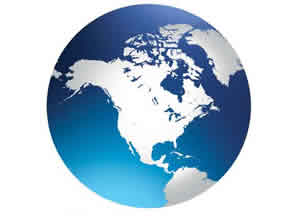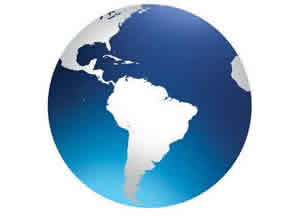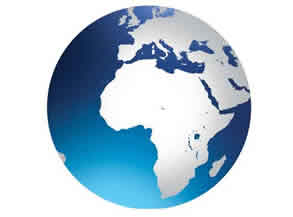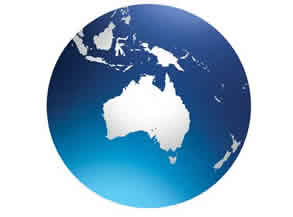SmartWay
 SmartWay International
SmartWay International
Get SmartWay Updates
Enter your email address to sign up for SmartWay e-Updates
Updates are sent once per month on average.
Trade growth has increasingly connected the global economy through the multimodal, global freight supply chain.
The goods movement supply chain extends well beyond the United States ports and borders, including multiple modes of transportation. As EPA works to broaden the capability of SmartWay to increase efficiency in the global supply chain, new opportunities are created to assist other countries, regions and trading partners with their Green Freight efforts.
As an established public-private, market-based partnership, SmartWay has proven to be a good template for replication by Green Freight programs in other countries and regions. Many countries have adopted elements of SmartWay or are looking for ways to implement SmartWay elements in their countries.
To help these and other countries address their concerns about energy security, economic vitality and climate change, SmartWay works with international stakeholders to help countries design, build and implement their own Green Freight programs. SmartWay developed the SmartWay Training Guide and Workbook: How to Develop a Green Freight Program: A Comprehensive Guide and Resource Manual (PDF) (198 pp, 7.7 MB, EPA-420-B-14-054, November 2014) as guidance on how to design, build and implement Green Freight programs outside of the United States. Spanish, French, Portuguese and Mandarin Chinese versions of this publication are available upon request.
EPA is also working with the Climate and Clean Air Coalition (CCAC)![]() to advance global Green Freight efforts as part of its commitment to the CCAC Heavy Duty Diesel Initiative
to advance global Green Freight efforts as part of its commitment to the CCAC Heavy Duty Diesel Initiative![]() . In response to the CCAC Green Freight Call to Action
. In response to the CCAC Green Freight Call to Action![]() , EPA is supporting the development of a Global Green Freight Action Plan
, EPA is supporting the development of a Global Green Freight Action Plan![]() .
.
More information on International Trade
"You will need Adobe Reader to view some of the files on this page. See EPA's PDF page to learn more."

North America
The trading relationship between the U.S., Canada and Mexico represents the largest trading bloc in the world, totaling over $630 billion in total trade for 2013. Significant volumes of manufactured goods and commodities cross our northern and southern borders each day, strengthening our economic ties but also causing greenhouse gases and criteria pollutant emissions. EPA is working closely with the governments and other key stakeholders in these countries to support their efforts to address their domestic freight sustainability challenges and to reduce transnational trade emissions.
Canada
Since 2012, implementation and administration of SmartWay began in Canada by Natural Resources Canada (NRCan). NRCAN has also established a freight program called FleetSmart![]() which teaches best practices for industry as well as safety techniques. EPA has also engaged Transport Canada on freight efficiency initiatives and aims to collaborate with both agencies on joint quantification and data sharing methods. The SmartWay Transport Partnership includes dozens of Canadian-based shippers and carriers.
which teaches best practices for industry as well as safety techniques. EPA has also engaged Transport Canada on freight efficiency initiatives and aims to collaborate with both agencies on joint quantification and data sharing methods. The SmartWay Transport Partnership includes dozens of Canadian-based shippers and carriers.
More Resources on SmartWay's relationship with Canada
- For more information regarding SmartWay in Canada, visit: http://oee.nrcan.gc.ca/transportation/business/smartway/18053

- To access the SmartDriver E-learning portal, jointly developed by EPA and NRCan to provide in-depth training on fuel efficient driving techniques, please sign up and log in at: http://fleetsmartlearning.nrcan.gc.ca/Saba/Web/Main

- Press Release: U.S., Canada Join to Cut Freight Industry Emissions and Save Fuel
- Information about FleetSmart can be found by calling 1-800-387-2000 or at FleetSmart.

EPA Clean Diesel Collaboratives in Canada
- The Blue Skyways Collaborative
 includes public and private interests from nine states, Canada, and Mexico seeking voluntary solutions, incentives, and shared approaches to reducing diesel and other fuel-related vehicle emissions and emissions from the energy sector in America's Heartland. The states are Arkansas, Iowa, Kansas, Louisiana, Minnesota, Missouri, Nebraska, Oklahoma, and Texas.
includes public and private interests from nine states, Canada, and Mexico seeking voluntary solutions, incentives, and shared approaches to reducing diesel and other fuel-related vehicle emissions and emissions from the energy sector in America's Heartland. The states are Arkansas, Iowa, Kansas, Louisiana, Minnesota, Missouri, Nebraska, Oklahoma, and Texas. - The Midwest Clean Diesel Initiative is a collaboration of federal, state, and local agencies, along with communities, non-profit organizations and private companies, working together to reduce emissions from diesel engines in the Midwest. The border is one of its areas of interest.
- The West Coast Collaborative
 is a public-private partnership working to reduce diesel emissions along the West Coast.
is a public-private partnership working to reduce diesel emissions along the West Coast.
Mexico
Secretaria de Medio Ambiente Y Recursos Naturales (SEMARNAT) established a green freight program for Mexico in 2010 called the Transporte Limpio![]() (“Clean Transportation”) program. The program is modeled after SmartWay, using similar tools and quantification and reporting methods. The program now includes about 150 partners and works to educate the industry on SmartWay technologies and operational practices. EPA has worked with SEMARNAT on program design and best practices since inception and continues to work with SEMARNAT to help advance joint goals for North America.
(“Clean Transportation”) program. The program is modeled after SmartWay, using similar tools and quantification and reporting methods. The program now includes about 150 partners and works to educate the industry on SmartWay technologies and operational practices. EPA has worked with SEMARNAT on program design and best practices since inception and continues to work with SEMARNAT to help advance joint goals for North America.
Commission for Environmental Cooperation
The North American Free Trade Agreement created a tri-national body called the Commission for Environmental Cooperation (CEC)![]() with the aim of ensuring environmental sustainability of goods movement under NAFTA. The CEC works with business, industry, government and other stakeholders in all three countries to improve freight efficiency and reduce emissions. The CEC completed a comprehensive study of the North American supply chain and published the Destination Sustainability report for the environmental Ministers and EPA Administrator. This report outlines sustainability scenarios for the trade corridor and makes policy recommendations that the countries may use as a basis for coordination and collaboration on infrastructure, border procedures, and standards harmonization. SmartWay tools, methods and practices are integral to these recommendations.
with the aim of ensuring environmental sustainability of goods movement under NAFTA. The CEC works with business, industry, government and other stakeholders in all three countries to improve freight efficiency and reduce emissions. The CEC completed a comprehensive study of the North American supply chain and published the Destination Sustainability report for the environmental Ministers and EPA Administrator. This report outlines sustainability scenarios for the trade corridor and makes policy recommendations that the countries may use as a basis for coordination and collaboration on infrastructure, border procedures, and standards harmonization. SmartWay tools, methods and practices are integral to these recommendations.

South America
South American policy makers are increasingly exploring opportunities to develop green freight programs for this continent. The Inter-American Development Bank developed a Climate Action Plan![]() includes freight sustainability initiatives. The World Bank assessed the prospects
includes freight sustainability initiatives. The World Bank assessed the prospects![]() for enhancing trucking efficiency in Brazil. The SmartWay program was presented at multiple workshops including an multi-national, multi-stakeholder workshop in Sao Paulo, Brazil, in September 2014. Based on findings from that workshop
for enhancing trucking efficiency in Brazil. The SmartWay program was presented at multiple workshops including an multi-national, multi-stakeholder workshop in Sao Paulo, Brazil, in September 2014. Based on findings from that workshop![]() , key stakeholders are working to establish a regional platform for dialogue and collaboration between multinationals and emerging national programs, and linking them with stakeholders and programs worldwide.
, key stakeholders are working to establish a regional platform for dialogue and collaboration between multinationals and emerging national programs, and linking them with stakeholders and programs worldwide.
Europe
Green Freight Europe![]() aims to be recognized as the leading independent voluntary program for improving environmental performance of road freight transport in Europe. Initiated in 2009 and launched on March 27th 2012 the industry-driven organization has grown to more than 180 multinational carriers, shippers and logistics service providers.
aims to be recognized as the leading independent voluntary program for improving environmental performance of road freight transport in Europe. Initiated in 2009 and launched on March 27th 2012 the industry-driven organization has grown to more than 180 multinational carriers, shippers and logistics service providers.
The program is a pan-European standard system for collecting, analyzing and monitoring CO2 emissions from road freight operations which is modeled on the SmartWay Transport Partnership. The group has grown over 60 companies working together with the Energy Saving Trust
Green Freight Europe aims to generate strong market incentives to engage companies across the supply chains in green procurement of transportation services in order stimulate long-term improvements.
The program drives reductions of carbon emissions by:
- Establishing a platform for monitoring and reporting of carbon emissions, to assist in the procurement of transportation services and based on existing standard.
- Promoting collaboration between carriers and shippers in driving improvement actions and monitoring progress.
- Establishing a certification system to reward shippers and carriers who fully participate in the program.
It is also the platform for companies to share best practices, promote innovations and communicate sustainability improvements on European road freight.
Furthermore, Green Freight Europe fosters cooperation with other related initiatives, programs and working groups globally.
Objectif CO2 France
The French Ministry of Ecology, ADEME created the Objectif CO2![]() program in 2008 as a national program to reduce CO2 emissions from road carriers and shippers in France.
program in 2008 as a national program to reduce CO2 emissions from road carriers and shippers in France.
Participating companies may join for free, and develop a personalized action plan to reduce CO2 emissions over three years. The first step in the action plan is develop the baseline CO2 emissions for the company’s fleet based on the current fuel consumption, number of vehicles, and annual distance traveled. Then the companies identify specific actions to implement based on a guideline document provided by Objectif CO2. Action areas involve changes to the vehicle, fuel consumption, driver behavior, and operational/logistic measures. The companies must choose at least one action to implement in each of these areas. They then estimate the potential CO2 emissions reductions to be realized by these actions. All of the data are entered into a centrally located Web tool at www.objectifco2.fr. The participants then report annually during the next three years using the same Web tool.
Almost 1,000 truck carriers companies have joined the Objectif CO2 program to date, which includes 113,000 vehicles (about 23 percent of the French fleet) and over 125,000 drivers. The projected potential emission reductions include over 760,000 tons of CO2 reduced per year and 260 million liters of fuel saved.

Asia
Trade growth between the US and Asian economies accelerated rapidly in the last decade with US-Chinese trade alone exceeding the combined US-trade with all other Asian trading Partners. EPA works closely with Asian countries on a wide range of collaborative projects, including SmartWay.
Green Freight Asia
Green Freight Asia (GFA) is a nonprofit organization funded and led by its member companies. Its key objective is to help lower fuel consumption across Asia-Pacific-sourced road freight movements, reduce CO2e emissions and air pollution from these movements, and lower shipping costs across the entire supply chain. Emissions estimates and performance metrics will be based on tank-to wheels CO2e, although PM and NOx evaluation may be added in the future. Although GFA does not intend to develop its own CO2e calculation and accounting methodology, it is committed to contribute to global alignment of these methodologies. The GFA program is currently funded by membership fees. Its membership is composed mostly of carriers and shippers.
GFA’s primary goals include:
- Educating all Asia-Pacific-based stakeholders (governments, manufacturers, logistics companies, and consumers) about sustainable supply chain practices.
- Creating a business-to-business green freight label certification and renewal process indicating a company’s degree of commitment to, and actual adoption of, sustainable supply chain practices.
- Aligning with other green freight programs and national initiatives to harmonize, avoid overlaps, and collaborate with other regional and global environmental NGOs.
China
EPA provided technical guidance for a successful Green Truck demonstration pilot in Guangzhou, China, in 2009. As part of the World Bank-funded Clean Air Initiative for Asian Cities (CAI-Asia)![]() , SmartWay technology was installed on three fleets of trucks to demonstrate the fuel saving benefits of advanced aerodynamics and improved tire systems. Test results were in the range of 2 percent to 18 percent fuel savings.
, SmartWay technology was installed on three fleets of trucks to demonstrate the fuel saving benefits of advanced aerodynamics and improved tire systems. Test results were in the range of 2 percent to 18 percent fuel savings.
View an informational video of the project.![]()
The projects success led to a $5-million grant from the Global Environment Facility to the World Bank to implement an extended project. The new projects goal is to retrofit over 2,000 trucks with SmartWay technologies. The project is leveraging an additional $17 million in co-financing to do capacity building with the Chinese trucking industry, with governmental authorities and shippers to implement a comprehensive supply chain sustainability program in Guangzhou. The SmartWay Transport Partnership, program design, carbon accounting tools and technologies will be integral to this effort. EPA is providing technical and program guidance for this effort.
Based on the success off these pilot demonstration efforts the Ministry of Transportation in China launched the China Green Freight Initiative![]() in 2012.
in 2012.
The CGFI is now in the initial design and development phase (Phase 1 of 3). During the first year of the program, the focus was on setting up the organizational structure of the CGFI. The organization includes a steering committee composed of the Ministry of Transport, the Ministry of Environmental Protection, the National Development and Reform Commission, the Ministry of Public Security, and the Ministry of Industry and Information Technology. There is also an expert group that provides technical guidance and input.
After development of the organization, the CGFI’s intent is to focus on including “avoid” (avoid empty weight trips, change logistics to reduce the number of trips), “shift” (shift to other forms of transport for goods), and “improve” (improve truck technology, fuel improvements, and improvements to driver behavior) strategies used in many green freight programs. Specifically, the CGFI intends to focus on green management strategies through logistics and planning, the use of green truck technologies, and implementing training to promote green driving. They will accomplish this in the road freight industry by developing emissions standards and fuel consumption limits, carrying out pilot projects and demonstrations, providing training, and developing consistent, recognized branding.
Japan
The Ministry of Economy, Trade and Industry (METI) launched a Green Distribution Partnership![]() in 2005. This Partnership is a collaboration of
in 2005. This Partnership is a collaboration of  freight shippers and carriers to reduce goods movement fuel use and CO2 emissions. Like SmartWay in the US, the Green Distribution Partnership promotes advanced technologies and other fuel saving best practices.
freight shippers and carriers to reduce goods movement fuel use and CO2 emissions. Like SmartWay in the US, the Green Distribution Partnership promotes advanced technologies and other fuel saving best practices.
Middle East
At this time there are no SmartWay projects in the Middle East.

Africa
SmartWay has received inquiries from the region, but does not have any project work within the continent at this time.

Australia
EcoStation![]() is a joint initiative between the Victorian Environment Protection Authority (EPA Victoria)
is a joint initiative between the Victorian Environment Protection Authority (EPA Victoria)![]() and the Victorian Transport Association (VTA)
and the Victorian Transport Association (VTA)![]() . EcoStation is a comprehensive resource centre for the freight industry that will assist individual companies to maximize their transport efficiencies and minimize their environmental impact.
. EcoStation is a comprehensive resource centre for the freight industry that will assist individual companies to maximize their transport efficiencies and minimize their environmental impact.
The key objectives of the EcoStation program are to make it as simple as possible for companies to take advantage of the innovations available, measure the efficiencies achieved, and enjoy the benefits that will ensue.
By joining the EcoStation program, over 25 companies agree to measure, reduce, and report emissions to EcoStation. EcoStation offers the tools and technical guidance to assist companies to baseline fuel use and emissions, and develop strategies to reduce emissions and improve efficiency.
Climate and Clean Air Coalition
The Climate and Clean Air Coalition (CCAC) was formed by the United Nations Environment Program and a collection of country actors and other stakeholders to mitigate the impacts of short-lived climate pollutants as a near term strategy to address climate change. This voluntary international partnership has brought together over 150 State and non-State Partners pledged to enhance global, regional, and national public and private efforts to reduce SLCPs with an initial focus on black carbon, methane and hydrofluorocarbons (HFCs). As part of its initiative on Reducing Black Carbon Emissions from Heavy Duty Diesel Vehicles and Engines, the CCAC is working to achieve substantial reductions of fine particulate matter and black carbon emissions from the transportation sector.
- United Nations High Level Assembly Global Green Freight Call to Action

- President Obama announces international commitments to cut carbon pollution through partnerships including the Global Green Freight Action Plan

- UN Climate Summit Action Statement
 on Global Green Freight
on Global Green Freight
